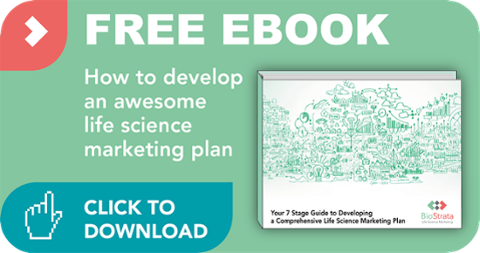As marketers, regardless of the type of content we are creating, we always aim to educate, inspire and entertain the reader. Not only that, we also hope to persuade them to take action—this could be to download an eBook, sign up for a mailing list or take advantage of an offer. Writing persuasive copy is no mean feat, so if you are keen to hone your writing to create copy that engages and delights, then read on!
On this topic, Nancy Harhut gave a great overview at a previous Inbound of the tactics and constructs you can use to immediately make your writing more persuasive. We’ve distilled some of our key takeaways from her talk here, so that you can quickly start implementing these tips yourself!
Blog Snapshot: Creating life science content that is educational yet persuasive is a difficult skill to master. At a previous Inbound conference, we went to a great talk on the key principles of writing persuasively. We have taken some of these principles and applied them to life science content marketing. Download our free eBook to find out what else makes up a great content marketing strategy.
Tip 1: Help close the gaps in your readers’ knowledge
As experts in a particular scientific discipline, we all have prior knowledge on a given topic, but that doesn’t mean our expertise is complete. This means there’s always a gap between what the reader knows and what they want to know, leaving them with questions that our content needs to answer. So, when crafting a story, you should always aim to answer clearly the key questions your readers might have. If you can do this, you’ll successfully draw their interest. Journalists have a handy rule of thumb for this; it’s called the ‘five Ws plus one H’ rule. They always address the ‘who’, ‘what’, ‘where’, ‘when’, ‘why’, and ‘how’ of a topic. Use these words in headlines, subject lines, copy and captions and address these questions in your text.
One way of really getting a handle on the types of questions your target audience are likely to want answering is by taking a buyer persona-driven approach to your content marketing strategy. This allows you to step into the shoes of your intended reader, and ask ‘how can my content help them reach their goals?’. We used this and the 'five Ws plus one H’ approach in the example below, which on this occasion, only required the use of three Ws!
Example: Perhaps you are considering writing a blog post which outlines the do’s and don’ts of maintaining sterile cell culture conditions. Consider starting with explaining who the blog post is aimed at (PhD students for instance), then move on to what the main topic of the piece is (maintaining sterile conditions in the lab), and then further explore the why (to ensure the reliability of your results) and the how (by observing these top tips, and perhaps considering using products that help maintain sterile conditions).
Tip 2: Engage the reader’s emotional brain by telling a story
Research has shown that people often make decisions for emotional reasons and only later use rational arguments to justify those decisions. This means that any content you produce should ideally have emotional as well as rational aspects. This ties in with the art of storytelling, which is crucial to getting people engaged and for messages to stick. A wonderful example, which Harhut gave in her talk, was the 'Significant Objects' project. In this project, journalists-turned-researchers purchased cheap, second-hand items such as jars of mayonnaise, plastic toy horses and wire baskets, and had writers create interesting stories to accompany the online listings. The items were sold for much more money than the objects were worth, because the buyers perceived the items as being of higher value.
For a story to have an impact, it must be engaging but also follow a clear and consistent structure. As many content creators know, a good structure consists of three parts: introduction, conflict and resolution. Randy Olson, a scientist and author, rebranded these three stages as ‘And’, ‘But’, and ‘Therefore’ (ABT). This method aims to create a clear narrative, meaning connections are drawn between different bits of information—building tension—which is then followed by a resolution.
Example: Perhaps you sell antibodies for the protein aggregated in Alzheimer’s disease. You could write about current developments in the field and the most cutting-edge techniques used today to study the disease. But there are still many unanswered questions and unexplained results. Therefore, use of your company’s antibodies will further our understanding of disease development and diagnosis, and aid in drug screens—bringing us closer to better diagnostics and medicines.
Tip 3: Keep your language as simple as possible
This one may come as a surprise to many, particularly those working in the life science industry. When people are better-informed, they feel more confident in their ability to make a decision, which is why it is so important in marketing to create content that is clear and concise. Nobody wants to feel like they need to put in huge amounts of effort just to stay focused on your message, or to even understand it in the first place. Therefore, Harhut recommends ‘KISS’: Keep It Simple, Stupid. This is a good strategy to ensure that long words, complex sentences and unnecessary jargon don’t get in the way of your story, ensuring the reader will really understand your message. Using overly complex words could even make you look less informed, which might compromise your credibility and distract readers from your core message. So, use simple words where possible!
Example: When sending out a promotional email, there is often no need to use jargon and complicated language. Your aim with the email is to persuade readers to take action—such as clicking on a link leading to a landing page with more information—not to provide detailed information on how your technology works then and there. Often keeping it short, sweet and to the point is the best approach.
Tip 4: Be concise and use ‘smart typesetting’
Nowadays, everyone is pressed for time, and we are forced to decide whether we’ll continue reading a particular blog post, article or eBook, or move on to more appealing content if what’s in front of us is not engaging. It is therefore crucial to summarise your most important points up front, rather than hide your message among overlong and unnecessary copy. This will ensure readers know immediately what they stand to gain from engaging with your content. Use bold text, subheadings and bullet points to guide the reader so it is clear what the key messages are, and which topics are covered.
Example: Let’s say you’re creating an eBook that shares some of your company’s new data and explains why this data is set to change the status quo. Try to resist diving straight into the background of the particular field, and instead provide a handy snapshot in the first few pages summarising what you will cover, what the data shows and why this is set to make waves in your particular discipline. Consider using creative elements like call-out boxes and bulleted lists to convey messages in a concise way.
Tip 5: Leverage 'social proof'
Us human beings are social creatures, and we therefore spend a lot of time seeking approval from our peers when we are unsure of what action to take. This is known as seeking social proof, and happens when we are faced with too many choices in life, or when there is no obvious route to take. We are also repeatedly taught to recognise and respect authority. These two factors can both be utilised when trying to persuade an audience, such as by implying a certain product or service is very popular in a specific demographic, or using (perceived) authority as the face of your product or service (e.g. through the use of testimonials, case studies, quotes and reviews).
Example: Imagine you are the manufacturer of cutting-edge microscopy equipment. Being able to state that you supply a large percentage of universities, naming some of your customers, or sharing links to highly cited research that used your equipment can convince readers that your company is a trustworthy source of information, support and technology.
In essence, creating powerful and persuasive content requires a true understanding of your target audience, a knack for making your copy educational, concise and carefully constructed, and a habit for utilising strategies that qualify your message (such as case studies, citations and voices of authority). Once you have a handle on these tactics and techniques, you can create content that will inform and inspire your reader.
If you want to learn about other components that make up a good marketing strategy, be sure to check out our eBook: The 7 step guide to creating a strategic marketing plan.





